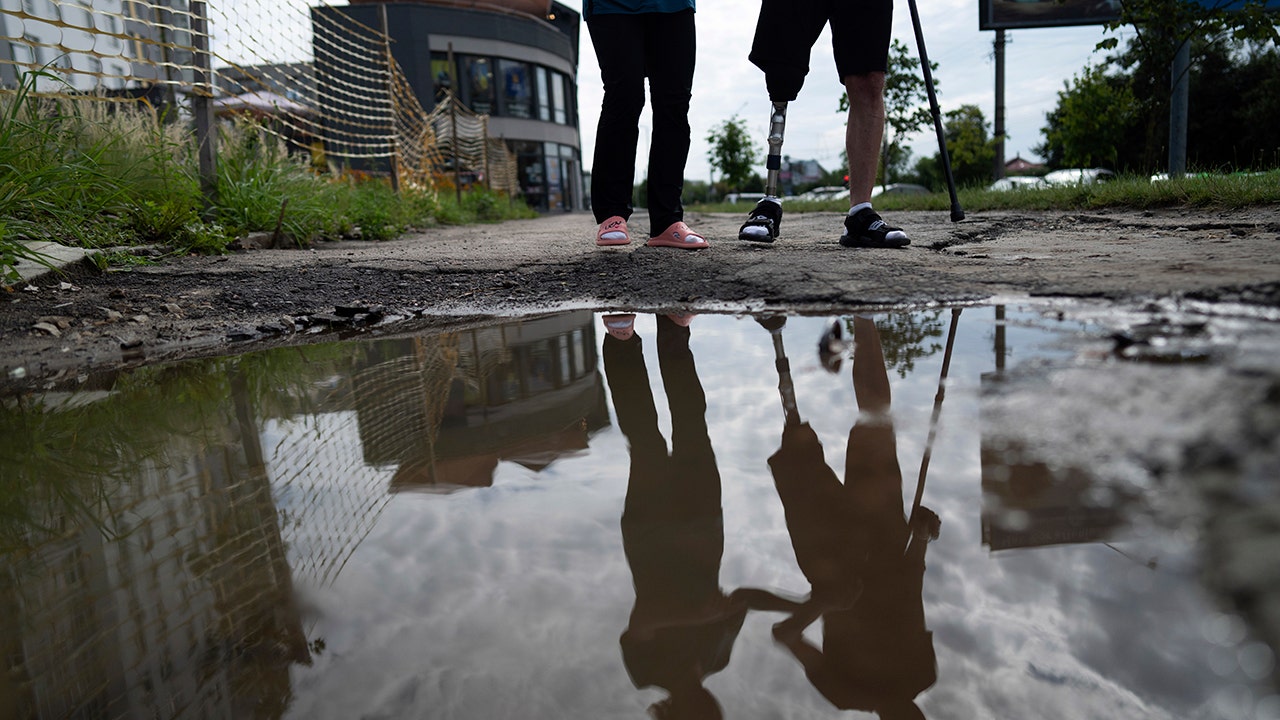In a display of camaraderie, a small group of soldiers gather outside to bond over cigarettes and share their war stories. Some of these conversations are lighthearted, while others are tinged with frustration due to the unreliable memories caused by their last day of fighting, the day they lost their limbs.
Certain soldiers vividly recall the moment they were injured by anti-tank mines, aerial bombs, missiles, or shells. However, for others, there are significant gaps in their recollection.
One soldier, Vitaliy Bilyak, bears a skinny body marked with scars that culminate in an amputation above the knee. After spending six weeks in a coma and undergoing over 10 surgeries to treat his injuries from driving over anti-tank mines on April 22, Bilyak describes his awakening as feeling reborn and returned from the afterlife. He is just beginning his journey of rehabilitation and awaits the fitting of an individually tailored prosthesis.
Ukraine faces the challenge of caring for an increasing number of amputees, with estimates reaching 20,000 individuals, many of whom are soldiers grappling with psychological trauma from their time at the front lines. This situation has not been seen in Europe since World War I, and in the United States, not since the Civil War.
Mykhailo Yurchuk, a paratrooper wounded early in the war near Izium, recalls being carried to safety by his comrades on a ladder for an hour. At that moment, he contemplated ending his life with a grenade. However, a determined medic refused to leave Yurchuk’s side, providing continuous support, even as he fell unconscious. Expressing his gratitude upon waking up in an intensive care unit, Yurchuk thanked the medic for holding his hand. In response, the medic dryly remarked that he was afraid Yurchuk would pull the pin. Yurchuk lost his left arm below the elbow and his right leg above the knee.
In the year and a half since his injury, Yurchuk has successfully regained both his mental and physical equilibrium. He met his future wife while in a rehabilitation hospital, where she volunteered. Today, he confidently cradles their infant daughter and takes her for walks without hesitation. His new prosthetic hand and leg stand out in striking black.
Yurchuk now serves as a source of motivation for newly arriving amputees from the front lines. He encourages them during the healing process and guides them as they learn to adapt to their new disabilities. Establishing similar connections, both formal and informal, throughout Ukraine will be crucial for the thousands of amputees in need.
Dr. Emily Mayhew, a medical historian at Imperial College specializing in blast injuries, explains that amputees require assistance from another human being as they undergo the complex process of reorienting their locomotive system and redistributing their weight.
Unfortunately, the number of prosthetic specialists in Ukraine is far from sufficient to meet the growing demand. Olha Rudneva, head of the Superhumans center for rehabilitating Ukrainian military amputees, reveals that prior to the war, only five individuals in the entire country possessed formal rehabilitation training for arm and hand amputations, which are less common than leg and foot amputations caused by complications from diabetes or other illnesses.
According to Rudneva, an estimated 20,000 Ukrainians have undergone at least one amputation since the start of the war. While the government does not disclose the breakdown, blast injuries are among the most prevalent in this long-lasting conflict. Rehabilitation centers such as Unbroken and Superhumans rely on funds from donor countries, charitable organizations, and private Ukrainian companies to provide prostheses for Ukrainian soldiers.
Interestingly, some donors are reluctant to offer direct military aid to Ukraine but are willing to support humanitarian projects like rehabilitation centers, as revealed by Rudneva.
For soldiers like Yurchuk and Valentyn Lytvynchuk, who completed his tenure as a battalion commander, there exists a longing to return to the front lines, even amidst their rehabilitation. Lytvynchuk derives strength from his family, particularly his 4-year-old daughter, who etched a unicorn on his prosthetic leg. Nevertheless, the reality of his physical limitations becomes apparent when he visits a military training ground, realizing he would require four-wheel drive to navigate trenches and acknowledging the tendency for his prosthesis to detach.
The most difficult aspect for many amputees is learning to live with the pain stemming from their injuries, prostheses, and blast shockwave effects. Dr. Mayhew, who has spoken with hundreds of military amputees throughout her career, attests to the challenge of addressing the comorbidity of post-traumatic stress disorder (PTSD) and blast injury alongside physical pain. Additionally, these individuals often undergo cosmetic surgeries to aid their reintegration into society, as they may feel disfigured and believe that others only perceive them by their injuries.
To accommodate severely injured individuals, rehabilitation may extend beyond the duration of the war itself.
Bilyak, the soldier who drove over anti-tank mines, occasionally finds himself dreaming of battle. In these dreams, he envisions Russians shooting at him point-blank, only to survive, defiantly gesturing at his assailants.
Denial of responsibility! VigourTimes is an automatic aggregator of Global media. In each content, the hyperlink to the primary source is specified. All trademarks belong to their rightful owners, and all materials to their authors. For any complaint, please reach us at – [email protected]. We will take necessary action within 24 hours.


